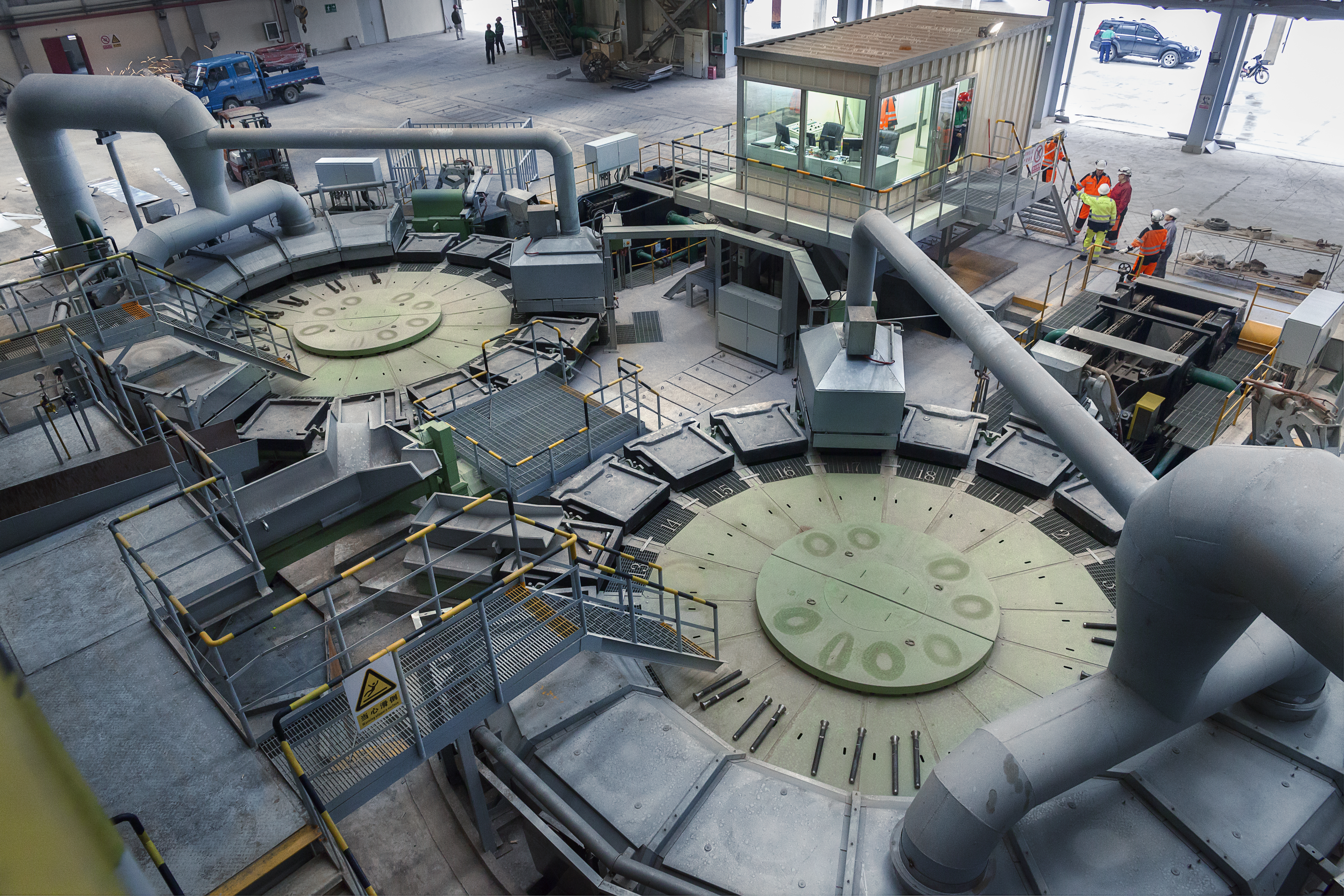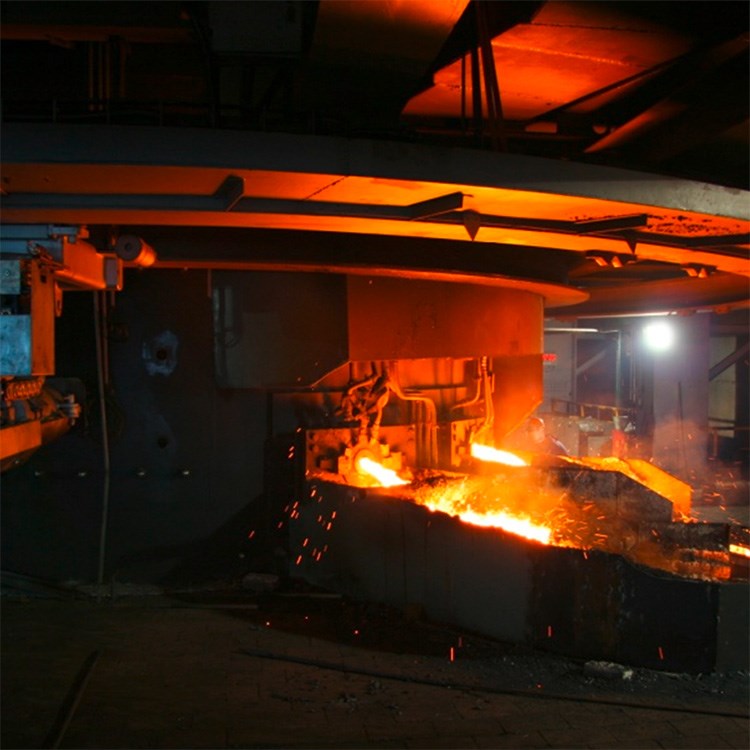How would you define high quality anodes and what is the role of anode casting shops in making them?
High quality anodes are uniform in weight and shape. The anode itself has a sharp form including the anode ear, but the overall surface quality needs to be smooth, and there should be no fins, bulges or cracks.
Anode quality depends on three main factors: equipment, consumption of materials and operation. Accurate and uniform weight of anodes is achieved with a state-of-the-art weighing and casting system. Continuous uniform thickness of the anodes can be ensured by using the Metso Outotec MouldSense monitoring system. To minimize the amount of mold coating material, the mold dressing equipment should feature adjustable coating thickness.
You also need to be able to minimize bulges and fins at anode sides. This can be done with correct pouring speed and wheel movement, but you also need to control the temperature of the molds and have proper mold dressing. A fully automated process plays a key role in ensuring the best end result.
Why is minimizing rejection rate so important and how can you impact it?
Every reject in the production wastes energy used in resmelting, materials, and adds to handling costs etc. Time and money are wasted. There are several ways you can decrease the reject rate. Firstly, you need to focus on the quality of the anodes as described above. Secondly, you need to optimize copper quality, temperature at the casting ladle, refractories, mold design and levelness, water quality and pressure, as well as air pressure and mold coating material.
The Metso Outotec MouldSense is an active mold condition monitoring system, which can significantly decrease the reject rate. It is based on a laser and camera combination that can physically measure the mold, and to recognize different disturbances on the mold. This system is standalone and can be added to any casting shop.
Sustainability has become more and more important in the manufacturing process evalution stage. What sustainability features should you be looking for in anode casting shops?
The new casting shops are electric instead of hydraulic. Besides being easier to install, they are safer and more environmentally friendly as no hydraulic oil needs to be used. This eliminates fire hazards, but also environmental concerns when no oil can leak into water circulation. To reduce emissions, hoods can be installed to gather steam which can then be further filtered. Closed water circuits can also be arranged.
Controllability of the machines is important, and there has been great improvement, which has also contributed to better safety in the casting shops. The machines can sense if they are using too much force and can stop very fast to minimize damages should there a collision situation.
Energy consumption is one thing to look for: Metso Outotec anode casting shops have been designed to store braking energy of the machines and feed it back to the grid. This way, part of the energy used in the shop can be produced in a similar manner like in a modern hybrid car.
What is the role of safety in modern anode casting, and how can you improve it?
Safety should always be at the core of the casting shop design. The Metso Outotec safety systems have been designed to comply with the strict European standards. Dangerous areas are separated by steel fencing. These are equipped with automatic safety locks which provide access to required areas by request only during production. This ensures that the employees can do their work safely. Most of the normal operation can be safely done from the control room. The equipment starts only once the operators have signed themselves away from the restricted area. The wheel and equipment stop in a safe manner so that harm to humans or equipment can be avoided.
How has the pandemic impacted installation and operation of anode casting shops – are the new practices and learnings that can be taken into ‘permanent’ use?
Unfortunately, the pandemic has restricted our experts from traveling to client sites. However, our large network of local service engineers around the world has been able to travel to the sites, and we have provided support from the headquarters. Together with our customers we have been able to set up remote systems with helmet cameras, fast network access to automation systems, and a remote monitoring support center in Finland to ensure safe installations and start-ups.
What are the future trends and developments to look for?
Further digitalization is definitely one of the key trends to look for. Asset analytics is becoming more and more important for evaluating asset ‘health’ and to provide failure diagnostics. In addition, remote diagnostics capabilities provided by the OEM for preventive maintenance and operation optimization will become more sophisticated. Metso Outotec’s and CIMS (casting information management system) can already now help to follow up production data.
Machinery will perform safely and precisely when it’s serviced accordingly. If you don't schedule service for your machinery, it might schedule it for you. Machinery breaking down at the wrong time will have a significant impact on the process. Usually, this is tackled with frequent service, but challenges remain: correct timing and logistics on ordering the spare parts, warehousing the right number of spare parts, and having the right people at the right time doing the maintenance work - just to name a few. Our solution called Asset Analytics offers a solution to these challenges by giving clear insight of the equipment usage statistics. In certain cases, it also gives heads-up before something is going to break in the near future. With this insight, our customers can plan their service activities efficiently to avoid costly unscheduled shutdowns.
We are working on many fronts in digitalization. One of these is process transparency and traceability. In practice, this means that we can have a chain of traceability from a single anode casted all the way from the electrolysis to the bosh tank water quality, mold condition, cooling water and even to the furnace environment variables at the cast time. Transparent process traceability enables our customers for tuning the process parameters for even better quality.
A safe and fully automated smelter keeps people out of the harm’s way and eliminates human errors. By utilizing safely designed and functional proven automation solutions we move towards a fully automated smelter, and eliminate accidents and human errors, as well as prolong equipment lifetime and increase process quality.
What makes Metso Outotec casting shop technology unique?
Metso Outotec anode casting shops are the result of dedicated development work with the customers. Our first casting shop was delivered already in 1973, and we’ve continuously developed them further based on the evolving customer needs. These include high yield and quality as well as minimized rejection rates through high reliability and anode quality. In addition, our high-quality structures are long-lasting and designed for easy maintenance.
To meet our customers’ demands, we’ve developed frontrunning anode casting shops that are hydraulic-free, electrically operated and safe. They use accurate and reliable self-adjusting operation, resulting in a fast and flexible material-handling chain. Operation is safe and easy due to an easy monitoring and control system. Metso Outotec anode casting shops are easy to increase in size and we have a unique network of experts around the world to support our customers.
More information:
Sami Maaniittu - Director, Anode Casting, Metso Outotec
Harri Majonen - Sales Director, Fire Refining and Anode Casting, Metso Outotec
This article is part of our Smelting Newsletter Issue 1/2021. Visit the issue front page for all articles and greetings from Jyrki Makkonen, Vice President of Smelting business line.

